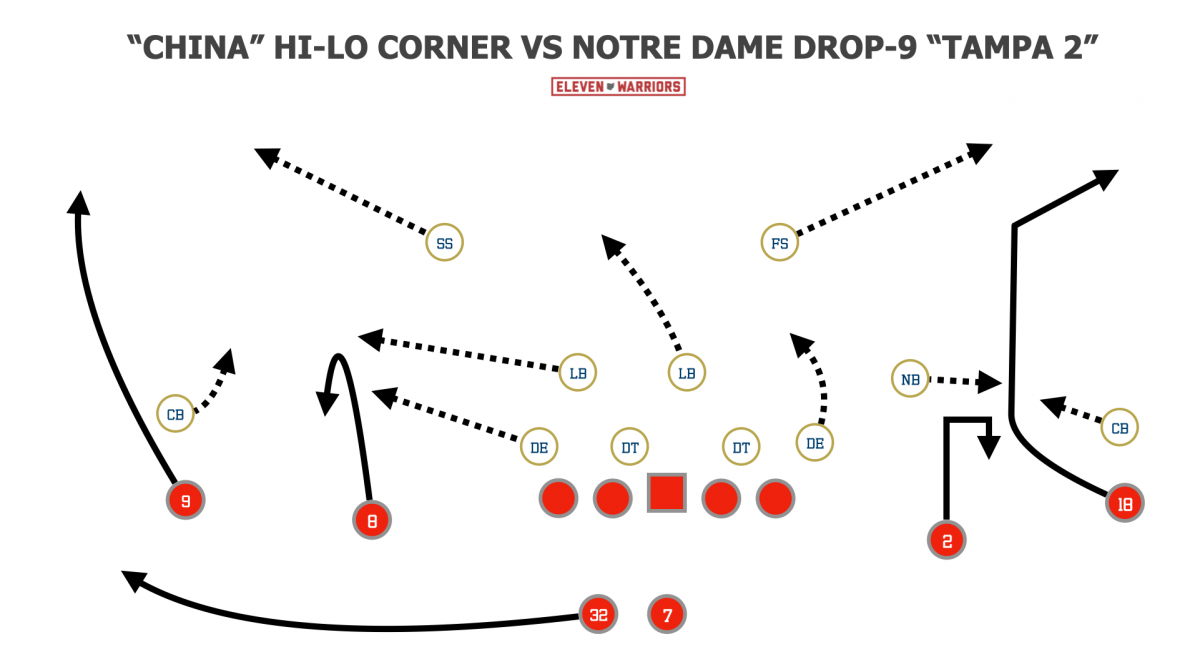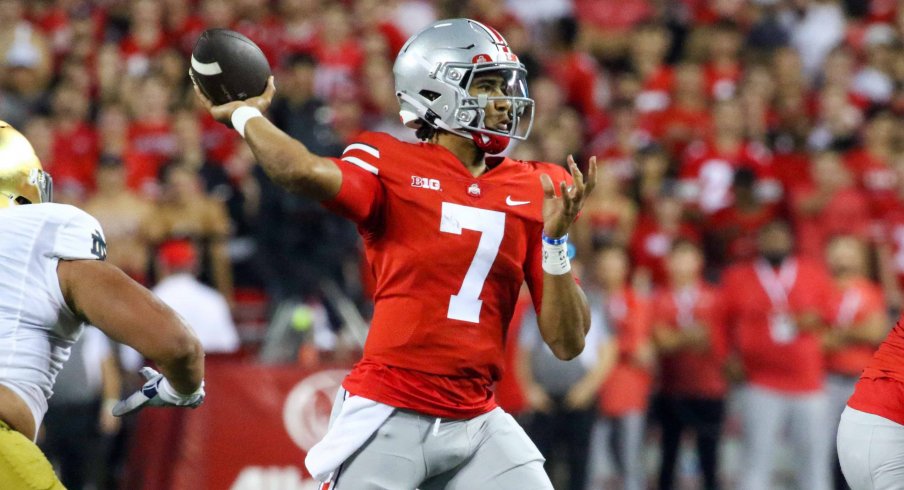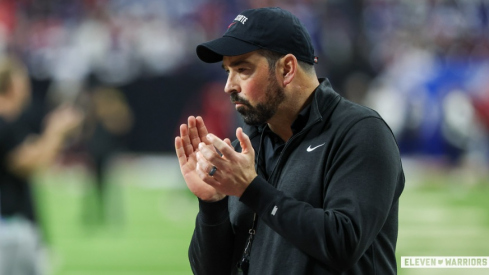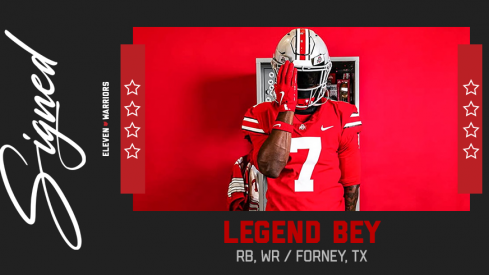A strange narrative emerged following Saturday night's contest in the 'Shoe.
According to many observers - both those in attendance and those watching from home - the Ohio State offense struggled in the season opener. Expected to pick up where it left off last season as easily the nation's best unit when in possession of the football, the Buckeyes tallied just 395 yards of total offense during its win over a top-5 opponent.
Perhaps this perception was due mostly to the score at halftime, with the home team trailing the visiting Irish by a score of 10-7. A team that punted a mere 31 times throughout the entire previous season had already trotted out Jesse Mirco to do his dirty work three times(!!!!) in the first two quarters.
Clearly, something was amiss.
To the naked eye, the loss of Jaxon Smith-Njigba to an early injury seemed to disrupt not only the timing of OSU's Heisman-contenting quarterback, C.J. Stroud, but the play-calls coming from the OSU sideline as well. Stroud admitted to the media earlier this week that the Buckeyes weren't entirely sure what to expect from Marcus Freeman's defense now that the first-year head coach had handed over coordinator duties to Al Golden, and it showed at times throughout the first half.
Rather than attack their opponent's weaknesses, as we've grown accustomed to seeing, Ryan Day and his offense seemed to be probing throughout the first half; searching for tendencies that only later could be exploited. For instance, an early RPO on 3rd & 2 seems a very curious call, given the defense's alignment in a five-man "Tite" front covering the center and both guards while the secondary employs man-coverage outside.
The Buckeyes consistently employed 'check with me' tactics in which Stroud would rush up to the line of scrimmage to get the defense to reveal its alignment before looking over to Day on the sideline for a new play-call. But on this occasion, that play didn't attack the weakness of what the defense had shown. Instead, the coverage forced Stroud to hand off into a crowded box rather than throw a covered bubble screen, and the Buckeyes were forced to punt.
But examples like that one were rarer than one might think, as the Buckeyes featured a more diverse run game than we've seen in some time.
Just two plays before that failed 3rd down, Day shifted Emeka Egbuka out of the slot and into a wing position off the left tackle. Given that the player in motion was only a receiver, the Irish defensive front didn't react.
But as the ball was snapped, Egbuka sprinted across the formation to lay a block on the outside linebacker, sealing the backside edge for Miyan Williams on a duo play. While the Buckeyes have employed that base concept countless times over the past few years, the added wrinkle of incorporating the slot like this shows that Day is once again looking to the Los Angeles Rams for inspiration, who often utilize star receiver, Cooper Kupp, in a similar capacity.
After a long offseason in which they appeared to take self-scouting very seriously, the Buckeyes seemed focused on breaking many tendencies of their own. Knowing opponents often set their run defense opposite the running back's alignment in shotgun sets, Day called for a variety of toss plays into the boundary out of that look against Notre Dame, gaining a numerical advantage while executing a basic, wide-zone blocking scheme.
By the second half, the Buckeyes had built serious momentum in the run game and were keeping the Irish defense on its heels.
“We had a couple plays for the fullback, didn't quite get to them, but they were ready," Day said this week of the variety of run plays called on Saturday night. "We did get pretty big down in the red zone once. I know Coach Tressel was looking for the power play, but we didn't get that one in there. But no, it was great.”
Ohio State may not have lined up in the I-formation and ran Tressel's favorite play in his honor, but I'm sure the man standing in Day's spot 20 years ago smiled when he saw his former team reach the red zone late in the fourth quarter. On the 12th play of the drive, the Buckeyes pulled both the guard and tackle from the right side to lead Williams around the left end on a Counter play, picking up 12 yards in the most physical way possible and setting up 1st & goal.
“It was a seven-minute drive there in the fourth quarter where typically in the past, we'd be going a little faster, and maybe trying to score a little faster,” Day said. “But we were controlling the game and we felt like if we scored there, we can make it a two-score game. And if we got one more stop, the game was probably over. And again, that's not typically how maybe we've done things in the past here, but when you're playing good defensively and you're running the football, a win’s a win.”
That physicality was cemented by the play of the OSU offensive line, which looks reenergized under the leadership of new coach Justin Frye. Not every concept we saw from the Buckeye running game was a new one, but the big boys up front proved up to the task of winning their battles along the line of scrimmage.
On the second play of that game-sealing touchdown drive that ate up most of the fourth quarter, the Buckeyes were backed up near their own goal line. But when a basic split-zone concept was called - the bread-and-butter run play for Ohio State since Day and Kevin Wilson arrived in 2017 - the scarlet & gray linemen executed it with near perfection.
Outside of right tackle Dawand Jones, who missed his block on an inside linebacker but whose massive frame still made the defender miss the ball carrier, the other four down linemen and tight end, Mitch Rossi put on a clinic for how to execute a zone run. Center Luke Wypler specifically shined here, chipping the 3-technique DT before climbing to the MIKE linebacker and driving him backward.
Due to the success of the run game, many fans and analysts believe the Buckeyes should have run the ball even more, especially early on after Smith-Njigba's injury. With Julian Fleming a late scratch, it meant Stroud was without two of his top targets for most of the night.
But despite some early hiccups in which his timing appeared to be off with their replacements, Stroud still put on a show for NFL scouts.
The game's first score came against a blitz on 3rd down in which the Irish sent six rushers and played man-coverage behind it. Stroud not only identified the coverage early, but he fired a dart to Egbuka opposite the cornerback's leverage, setting up his receiver for a big run after the catch.
The Irish played more man-coverage than Stroud and the Buckeyes had anticipated, but the sophomore QB looked like a poised veteran, recognizing pressure and anticipating open windows downfield. By late in the third quarter, Stroud knew to expect pressure from the ND defense on 3rd downs and wasn't rattled before throwing the go-ahead touchdown pass.
"So as I'm going to snap the ball, I was wondering like, 'Okay, what is my [Cover] zero plan?' and that's what the play was," Stroud said of his thought process before the touchdown strike to Johnson. "So I just see the [safeties] coming from depth, I took my drop, tried to get it out of my hand, and X did a good job of winning his route on his man."
While many were disappointed with Stroud's pedestrian stat-line of 24-34 for 223 yards, his performance on 3rd down was spectacular, completing 8 of 10 for 118 of those yards and both scores. Much of this was due to his (and his coaches') ability to recognize Notre Dame's coverage as the game wore on.
Stroud still had Marvin Harrison Jr. lining up at the X receiver spot, and the duo began picking apart the Irish defense throughout the second half. Four of Harrison's five catches came after the break, with his QB perfectly anticipating the sophomore receiver's timing and firing strikes outside the numbers.
As seen above, the Irish played a lot of man-coverage on early downs while sending a blitz on 13 of Stroud's 35 dropbacks. But Freeman and Golden mixed it up on 3rd downs, mixing in a heavy dose of zone coverage with eight or sometimes even nine defenders dropping in coverage.
Stroud noted that he expected the Irish to play some Cover 2 throughout the game but probably didn't anticipate he'd see it with eight defenders clogging the zones underneath. But when the Buckeyes called for a China concept that sent the outside receiver on a deep corner route against a safety playing deep half, Stroud dropped in a pass to Harrison with ease.

“Just looking at the film, definitely think we did some great things on offense, moving the ball when we had to,” Stroud said. “Pass protection was amazing all night. My O-line did a great job, and [Notre Dame] even dropped nine and we still got a third-down conversion, so I'm proud of my guys for just keep fighting it out.
But Stroud's most impressive moment came when the Irish knew what was coming. Clearly having scouted the OSU offense and its tendencies the year prior, they anticipated when Day would call for his trademark crossing routes, applying the best call possible to stop the infamous Mesh concept.
By dropping eight into coverage with a pair of "robbers" in short zones underneath to help the defenders manned up outside, Notre Dame clogged the middle of the field and forced Stroud to improvise. When a pass rusher broke through and collapsed the pocket, Stroud showed the athleticism many believe he lacked to keep the play alive before finding Williams on a scramble drill down the sideline to keep the chains moving.
The Buckeyes may have failed to put on the same kind of show they often put on in the back half of last season, terrorizing defenses through the air and scoring points with relative ease. With so many pieces back this season, it's no wonder that many expected that trend to continue.
But when it came to game-planning, Day and his offensive staff were at a clear disadvantage, as they were forced to prepare for a variety of potential looks without knowing what to expect from these Irish. They couldn't simply study last year's Notre Dame defense and had to go back to Freeman's years coaching under Luke Fickell at Cincinnati as well as Golden's time with the Bengals, and as a result, spent much of the first half trying to decipher what the visiting defense was doing.
Meanwhile, the Irish knew what to expect from the Buckeyes and had a clear plan for stifling a unit without two key pieces in Smith-Njigba and Fleming. However, it didn't take too long for Stroud and co. to recognize where the Irish were vulnerable.
As the 2022 season wears on, no opponents will be able to surprise the Buckeyes the same way, as the scouting infrastructure inside the WHAC should give Day and his staff all the information they need to find weaknesses before kickoff.
“Looking back, we could have been more efficient, certainly in the first half on offense, because every play matters in those styles of games,” Day said at Tuesday’s press conference. “But I thought the attitude was excellent. I thought the toughness was excellent, I thought the way we played; we took care of the football, we tackled well, those are the things you need to do in opening games. And certainly, with the help of the crowd, we were able to kind of push through in the fourth quarter.”



